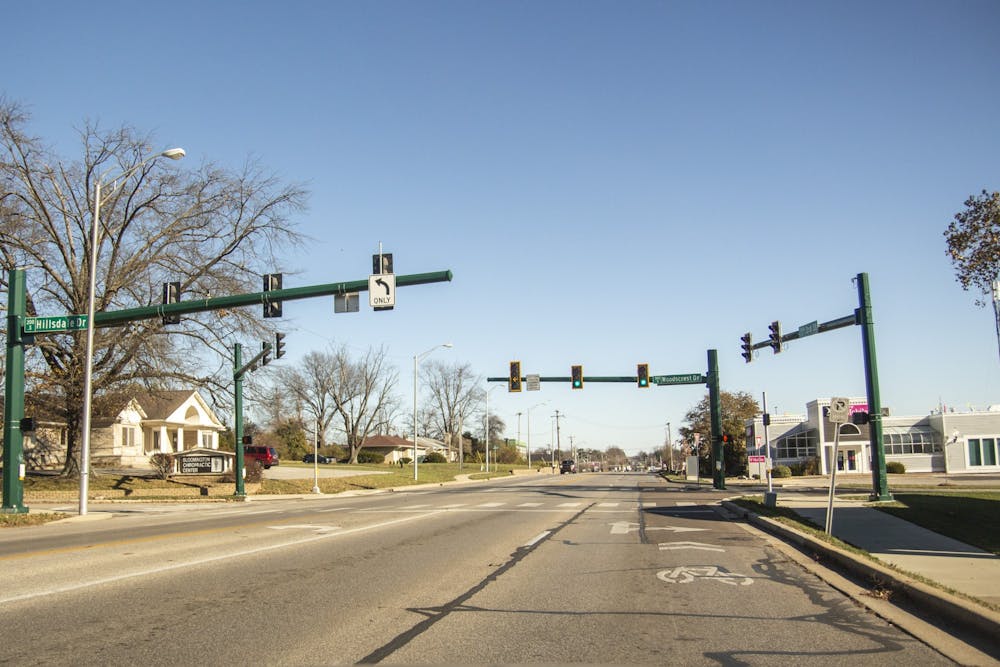This semester, the long-term closing of East Kirkwood Avenue to cars amid the COVID-19 pandemic made an already pedestrian-friendly part of Bloomington much safer, environmentally friendly and more walkable.
Restaurants like the Village Deli and Nick’s English Hut now boast permanent outdoor seating — a critical safety measure in a pandemic — while pedestrians have more space to social distance when walking. Closing Kirkwood has been an undeniable success, and Bloomington city government certainly made the right call in October to keep the closures in place indefinitely.
But while Kirkwood is now more pedestrian-friendly than ever, the outskirts of Bloomington — especially the region nearest to College Mall — are not.
Bloomington suburbs are nearly unwalkable and epitomize all the negatives of the urban sprawl epidemic that has taken our country’s suburbs by storm through poor city planning. The areas feature cul-de-sac after cul-de-sac, with no way in or out except by car, depriving neighborhoods of local amenities and opportunities. This leaves residents with few destinations easy to reach by bike and even fewer walkable ones.
While a disaster for sustainability, this is also an abject failure in urban planning, contributing to less satisfying neighborhoods, increased transportation emissions and a nearly absent sense of community.
One of the most obvious failures of planning occurs in and around College Mall. While a significant portion of Bloomington’s residents — especially near East Third Street — are college students without a car, the walk to College Mall from campus is hostile and dangerous to pedestrians.
The sidewalks are tight and close to the road, a hazardous setup when considering the street’s speed limit is 35 miles per hour. The intersection of College Mall Road and East Third Street, a massive intersection, has poor signage for pedestrians. In my experience, cars frequently turn right in front of pedestrians because they do not see them or are not expecting pedestrians at the intersection.
These problems could easily be avoided through better planning and better foresight. Installing more signage alerting motorists to the presence of pedestrians at the intersection would increase drivers’ awareness, making it easier for pedestrians to cross the intersection.
Reducing the width of both Third Street and College Mall Road is also critical. According to the National Association of City Transportation Officials, lane widths of just 10 feet are successful in urban areas. Narrower streets promote safety without compromising traffic flow, helping pedestrians to more safely reach their destination.
Heading south on College Mall Road, Bloomington residents encounter a different misstep in urban planning: a preponderance of culs-de-sac and unwalkable suburban areas. The area south of the Kroger on College Mall Road is nearly devoid of anything but single-family homes, leaving residents with no walkable — or even safe to bike — destinations.
The need to use a car to get everywhere isn’t just annoying. It’s also proven to harm residents’ health and social needs, while stymying local economic development.
Highly walkable neighborhoods have lower rates of obesity, according to the Washington Post. Less walkable neighborhoods have less of a sense of community and fewer opportunities for social interaction among residents. Walkable areas also have higher rates of economic development, greater economic resilience and increased tourist appeal.
When shops are clustered in one area, pedestrians can browse multiple shops in a short period of time, causing them to spend more time and money in the area. Higher walkability also raises real estate property values. According to Walk Score, which measures walkability in areas across the United States, a home’s property value increases on average by $500 to $3,000 for each point it earns towards walkability.
Bloomington’s overall Walk Score is 43, meaning it’s a car-dependent city. Residents generally have fewer opportunities to engage with the best parts of the city, go to a grocery store, their doctor or a restaurant without a car. But that number is just the average for the whole city. The eastern suburbs’ scores are far worse.
Some eastern neighborhoods, such as the 47401 zip code, have an abysmal Walk Score of nine, meaning it’s nearly impossible to access anything except by car. 47404 gets a score of 0.47. My zip code is the second most walkable zip code in Bloomington. Even so, it gets a Walk Score of 39, meaning it’s still car-dependent.
While Bloomington’s eastern suburbs are almost fully developed, policies can be implemented that will drastically increase the area’s walkability. Speed limits should be decreased and roads should be made smaller in order to decrease pedestrian exposure to cars, one of the major deterrents to walking. The city can also look to make more areas mixed-use, meaning homes are integrated in areas with small businesses. This concept promotes walkability by giving residents local hubs as walking destinations.
Bloomington’s downtown and other areas are highly walkable and safe for pedestrians, but the outskirts of the city can and should do better to ensure everyone has the ability to get to their destination without a car.
More walkable communities are more sustainable, healthier and more community-oriented. As a small city, Bloomington should be on the forefront of new ideas in urban planning and urban design. The city should take this opportunity to develop its outskirts in a more sustainable and community-oriented way.
Sarah Waters (she/her) is a freshman pre-law student studying law and public policy. She is involved with College Democrats at IU and the Hutton Honors Council Association.






